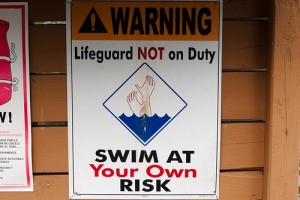In the last post I discussed how I have come to learn about the different kinds of MOOCs through my participation in etmooc. I also said that through learning about a new kind of MOOC, the cMOOC or “network-based” MOOC, I was reconsidering my earlier concerns with MOOCs. Might the cMOOC do better for humanities than the xMOOC?
A humanities cMOOC
 “Roman Ondák”, cc licensed ( BY ) flickr photo shared by Marc Wathieu
“Roman Ondák”, cc licensed ( BY ) flickr photo shared by Marc Wathieu
I haven’t yet decided whether or not one could do a full humanities course, such as a philosophy course, through a cMOOC structure. Brainstorming a little, though, I suppose that one could have a philosophy course in which:
- Common readings are assigned
- Presentations are given by course facilitators and/or guests, just as in etmooc
- Participants are encouraged to blog about the readings and presentations and comment on each others’ blogs (through a course blog hub, like etmooc and ds106 have)
- Dedicated Twitter hashtag, plus a group on a social network like Google+, and a group on a social bookmarking site like Diigo (see etmooc’s group site on Diigo)
- Possibly a YouTube channel, for people to do vlogs instead of blogs if they want, or share other videos relevant to the course
Would this sort of structure be more likely to allow for teaching and practice of critical thinking, reading and writing skills, as I discussed in my earlier criticism of MOOCs (which was pretty much a criticism of xMOOCs)? I suppose it depends on what is discussed in the presentations, in part. The instructors/facilitators could model critical reading and thinking, through explaining how they are interpreting texts and pointing out potential criticisms with the arguments. They could talk about recognizing, criticizing, and creating arguments so that participants could be encouraged to present their own arguments in blogs as clearly and strongly as possible, as well as offering constructive criticisms of works being read–as well as each others’ arguments (though the latter has to be undertaken carefully, just as it is in a face to face course).
This would involve, effectively, peer feedback on participants’ written work. Rough guidelines for blog posts (at least some of them) could be given, so that in addition to reflective pieces (which are very important!) there could also be some blog posts that are focused on criticizing arguments in the texts, some on creating one’s own arguments about what’s being discussed, etc.
What you wouldn’t be able to do well with this structure are writing assignments in the form of argumentative essays. These take a long time to learn how to do well, and ideally should have more direct instructor/facilitator feedback rather than only peer feedback, in my view. Peer feedback is important too, but could lead to problems being perpetuated if the participants in a peer group share misconceptions.
Another thing you can’t do well with a cMOOC is require that everyone learn and be assessed on a particular set of facts, or content. A cMOOC is better for creating connections between people so that they can pursue their own interests, what they want to focus on. Each person’s path through a cMOOC can be very different. Thus, as noted in my previous post, there is not a common set of learning objectives; rather, participants decide what they want to get out of the course and focus on that.
One would need to have a certain critical mass of dedicated and engaged participants for this to work. If it’s a free and open course, then people will participate when they can, and can flit in and out of the topics as their time and interest allows. That’s fantastic, I think, though if there are few participants that might mean that for some sections of the course little is happening. So having a decent sized participant base is important. (How many? No idea.)
I envision this sort of possibility as a non-credit course for people who want to learn something about philosophy and discuss it with others. Why not give credit? There would have to be more focus on content and/or more formal assessments, I think (at least in the current climate of higher education).
A cMOOC as supplement to an on-campus course
Even if a full cMOOC course in philosophy or another humanities subject may not work, I can see a kind of cMOOC component to philosophy courses, or Arts One. In addition to the campus-based, in-person course, one could have an open course going alongside it. This is what ds106 is like. One could have readings and lectures posted online (or at least, links to buy the books if the readings aren’t readily available online), and then have a platform for students who are off campus to engage in a cMOOC kind of way.
Then, those off campus can participate in the course through their blog posts and discussions/resource sharing on the other platforms, like we do in etmooc. Discussion questions used in class could be posted for all online participants. Students who are on campus could be blogging and tweeting and discussing with others outside the course as well as inside the course.

Frontispiece to Mary Shelley’s Frankenstein (1831),by Theodor von Holst [Public domain], via Wikimedia Commons. One of the texts on Arts One Digital.
Arts One has already started to move in this direction, with a new initiative called Arts One Digital. So far, there are some lectures posted, links to some online versions of texts, twitter feed, and blog posts. This is a work in progress, and we’re still figuring out where it should go. I think extending the Arts One course in the way described above might be a good idea.
Again, the main problem with this idea (beyond the fact that yes, it will require more personnel to design and run the off-campus version of the course) is getting a high number of participants. It won’t work well if there aren’t very many people involved–a critical mass is needed to allow people to find others they want to connect with in smaller groups, to engage in deeper discussions, to help build their own personal learning network.
Looking back at previous concerns with (x)MOOCs
Besides general worried about their ability to help students develop critical skills, I was also concerned in my earlier post with the following:
- In the Coursera Course on reasoning and argumentation (“Think Again”) that I sat in on briefly, I found myself getting utterly overwhelmed by the number of things posted in the discussion board. I complained that I could scroll and scroll just to get through the comments on one post, to get down to the next post, and repeat for each of the thousands of posts. Even for one topic there were just too many posts.
- I felt that the asynchronous discussion opportunities weren’t as good as synchronous ones, which allow for groups to be in the same mind space at the same time, feeding off each others’ ideas and coming up with new ideas. With asynchronous discussions, one might not get a response to one’s idea or comment until long after one has been actively thinking about it, and then at that point one may not be as interested in discussing it anymore (or at the very least, the enthusiasm level may be different).
- The synchronous option of Google Hangouts seems to be a promising way to address the previous point, but I noted in my earlier post that there had been some reports of disrespectful behaviour in one or two of those in the “Think Again” course. I said I thought a moderator would be needed for such discussions, just as we have in face to face courses to ensure students treat each other respectfully.
Can a cMOOC address these concerns?
- From my experience with etmooc, the discussion does not have to get overwhelming. The thing is, each person focuses on what they want to focus on from the presentations, or from what others have said in their blogs, or from resources shared by others. There is no single “curriculum” that we all have to follow, so it’s not the case that everything posted by each person is relevant to everyone else’s interests and purposes for the course. This could be true of a philosophy or Arts One cMOOC as well, so it could be easier to pick and choose what, amongst the huge stream of things to read and think about, one wants to focus on.
- Synchronous discussions are difficult in a large group. In etmooc we have some opportunities for them in the presentations, which allow for people to write on the whiteboard, engage in a backchannel “chat,” and also take the mic and ask questions/offer comments. One could have the presentations have more time for discussion, perhaps, which could take place in part on the chat and in part via audio. It’s not as good as face to face discussions, though–much more fragmented.
- Google Hangouts are an alternative, though I haven’t tried doing one in etmooc. Some have, though, and reported success. However, the people taking etmooc are mostly professionals, both teachers and businesspeople, and they are both highly motivated and responsible/respectful. Having Google Hangouts where anyone in the world can show up could be inviting trouble. I don’t see a cMOOC addressing this problem.
cMOOCs in humanities–what’s not to love?
What other problems might there be with trying to do a cMOOC in humanities, whether on its own or as a supplement to another course? Or, do you love the idea? Let us know in the comments.
UPDATE: I just found, in that wonderfully synergistic way that etmooc seems to work, this blog post by Joe Dillon, which explains how well a cMOOC like etmooc stacks up to a face to face course. It’s just one example, but it can provoke some further thought on whether a cMOOC for humanities might be a good thing.









